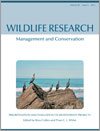
Wildlife Research
Volume 40 Number 2 2013
Prioritisation and Evaluation of Biodiversity Projects
WR12064Purposes, outcomes and challenges of eradicating invasive mammals from New Zealand islands: an historical perspective

Invasive mammals are increasingly being eradicated from islands because of their role in numerous extinctions of native species. In New Zealand, 181 populations of 15 species of mammalian pests have been removed from over 100 offshore islands (>45 000 ha total area), with benefits for numerous species of native plants, invertebrates and vertebrates. These successes have been derived from a supportive legislative environment, careful attention to technological development, partnerships with Māori, and innovative projects with community groups. Photograph by David Towns.

Few countries have sufficient resources to manage all threats to species and habitats, hence there is a need to prioritise where and how to manage biodiversity. Approaches and software to tackle the prioritisation imperative have evolved from a focus on reserves to, increasingly, the expected costs and benefits from biodiversity protection actions. Modern prioritisation approaches can identify the most cost-effective biodiversity protection actions, and if implemented by managers, offer the best chance to stem the threats to biodiversity. Photograph by Ross Cullen.

Many biodiversity objectives have been proposed for the Noah’s Ark problem – the problem of allocating limited funds to conservation projects – yet little consensus has emerged. The economic objective of biodiversity value, which attempts to gather all aspects of biodiversity into a single measure, is incomplete due to the uncertainty inherent in complex ecological systems. Instead, applying a version of the precautionary principle and minimising the regret of conservation decisions requires a conservation objective of ecosystem resilience. Photograph by Steven Smith.
WR12072Designing a practical and rigorous framework for comprehensive evaluation and prioritisation of environmental projects

Environmental managers face difficult decisions regarding the design and prioritisation of potential projects. Based on practical experience and sound theory, a tool has been developed to assist managers in this task: the Investment Framework for Environmental Resources (INFFER). Key lessons include that managers need a tool that is relatively simple and well supported, and that use of a theoretically sound metric to rank projects can dramatically improve the environmental values achieved. The tool is being widely applied. Photograph by Geoff Park.
WR12102Assignment of measurable costs and benefits to wildlife conservation projects

Prior to undertaking a wildlife conservation project, wildlife managers and policy makers must accurately determine the project’s economic impact to ensure public funds are used efficiently. However, it can be difficult to provide a comprehensive estimate of the benefits and costs associated with conservation. We identify the types of benefits and costs that arise from conservation projects and examine a number of well-developed techniques that economists use to convert benefits and costs into monetary values, also allowing projects to be compared. Photograph by USDA/APHIS/Wildlife Services.
WR12073Biological and operational determinants of the effectiveness and efficiency of biodiversity conservation programs

Evaluation of biodiversity conservation programs is critical to ensure that conservation spending is efficient. Success of species conservation plans in the UK is affected by biological factors such as how widespread a species is, but also by operational factors such as the complexity of conservation plans. Effective conservation planning requires the clear definition of roles and responsibilities at the outset, as well as the collection of high-quality data on both outcomes and costs. Photograph by GWCT/Peter Thompson.
WR12083Planning impact avoidance and biodiversity offsetting using software for spatial conservation prioritisation

Biodiversity offsetting concerns the allocation of compensation measures for unavoidable environmental damage caused by economic activity; in many countries, offsetting has been taken as a component of environmental legislation. Here, I describe how offsetting can be designed using publicly available software for spatial conservation planning. This work develops our understanding about how biodiversity conservation can be allocated in a well informed manner. Photograph by Evgeniy Meyke, Atte Moilanen and the Zonation team.
WR12205Interdisciplinarity in biodiversity project evaluation: a work in progress

An increasing number of methods are available to help inform decisions on how best to allocate scarce conservation resources, but their use has been relatively limited. One reason suggested for this is a lack of research interest, especially in interdisciplinary approaches that integrate the natural and social sciences. Our research suggests that biodiversity project evaluation may be developing along at least three, relatively distinct, pathways, and that greater integration and learning between the disciplines is needed to develop robust evaluation methods that are used more widely by decision-makers. Photograph by Ross Cullen.



